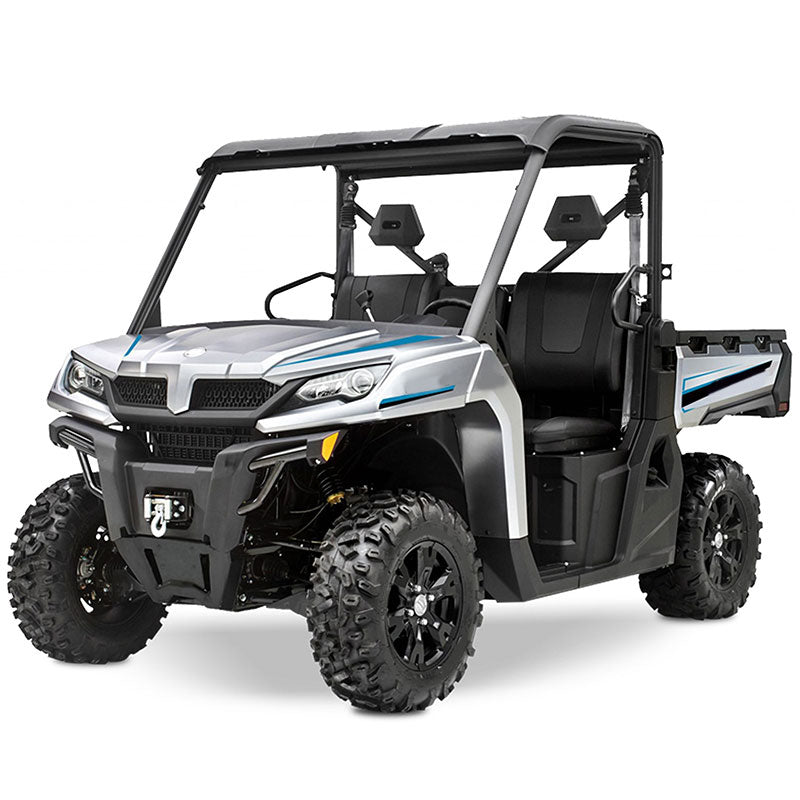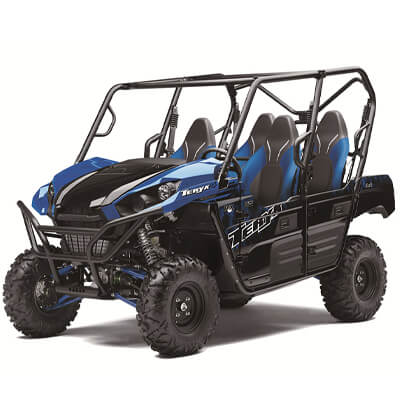How Much Does a Kawasaki Mule Weigh?

Kawasaki Mule: Weight and Performance Breakdown
The Kawasaki Mule has been a popular choice among UTV owners since its introduction into the market way back in 1988. When first conceived in 1980, the goal was to design “a vehicle with four wheels that could carry two people and heavier loads than an ATV.” As the concept evolved from table napkin drawing to full-fledged production vehicle, the Kawasaki Mule hit the market targeting buyers who wanted a featherweight workhorse with enough grunt and payload capacity for more demanding tasks. In this comprehensive guide, we'll put the entire Kawasaki Mule range on the scale to examine each model’s weight as well as its implications for both work and recreational use.
Weight Ranges in the Kawasaki Mule Line-Up
Since then, the Kawasaki Mule range has grown to offer an extensive lineup of varying configurations, each one notching up in weight as more features get added to meet specific needs and use cases. Let's break down the weight specifications across different model ranges:
- Kawasaki Mule SX Series: 1,000-1,200 lbs • Kawasaki Mule 4000 Series: 1,300-1,500 lbs • Kawasaki Mule PRO Series: 1,500-1,900 lbs • Kawasaki Mule PRO-FXT (with Trans Cab): 1,800-2,100 lbs
Keep in mind that these weight estimates are dry weights—meaning they don't include fluids, fuel, or any additional accessories. When you add passengers, cargo, or accessories, your actual vehicle weight will increase.
Which Factors Affect Your UTV's Weight?
Now that we’ve looked at the weight ranges for the Mule series, we can dive into some of the main factors that contribute to the Kawasaki Mule’s (or any UTV's) actual operating weight. Having a thorough understanding of these elements will help you better manage your vehicle’s performance and capabilities:
- Base Model Specs: Each trim level in the Kawasaki Mule lineup comes equipped with different trim features that affect the base weight. For example, 4x4 models or crew cab models with additional comfort features typically weigh more than basic utility versions.
-
Additional Accessories: Often overlooked for their contribution to vehicle weight, aftermarket additions such as roof panels, windshields, storage boxes, winches, and protective equipment can significantly increase the weight of your UTV. Just look at these weight ranges for popular accessories:
- Roof panels: 30 to 50 lbs.
- Windshields: 15 to 25 lbs
- Storage boxes: 20 to 40 lbs each
- Winch systems: 40 to 60 lbs
-
Cargo and Passengers: UTVs don’t drive themselves, so remember to factor in the combined weight of the drive along with any passengers and cargo when calculating total vehicle weight. For a better picture of the impact on weight, consider these average weight estimates:
- Average adult passenger: 150 to 200 lbs
- Typical cargo loads: 200 to 1,000 lbs.
- Tools and equipment: 50 to 200 lbs
-
Fuel: An easily overlooked component of any weight calculation is fuel tank load. A full tank of fuel adds considerable weight compared to an empty tank. For example:
- Typical fuel capacity: 7-9 gallons
- Weight of fuel: approximately 6 lbs per gallon
- Total fuel weight: 42 to 54 lbs. when full.
How Weight Affects Performance
The weight of your Kawasaki Mule will ultimately impact several aspects of the vehicle’s performance. Too many passengers, cargo, or accessories can negatively impact the vehicle's everyday utility, so it's crucial to understand the relationship between these elements to optimize your vehicle's operations.
- Traction & Handling: Keeping an even distribution of weight across the vehicle will help maintain optimal levels of traction throughout various surfaces. Front-to-rear weight balance affects the UTV’s ability to perform even the simplest maneuvers and will almost definitely impede more advanced maneuvers if not properly optimized. This can include anything from turning, braking, mud-crawling, and hill climbing.
- Fuel Efficiency & Cooling: A loaded-down Kawasaki Mule is going to impact fuel consumption as the increased engine strain will cause it to burn more fuel. Not only that, the added weight increases the rolling resistance to the vehicle, making it generally more difficult to get things moving from a stop as well as efficiently maintain momentum. On a hot day, all of this added strain from increased weight can also increase the vehicle’s demand for cooling, so be sure to keep an eye on those temperature gauges.
- Payload Capacity: One of the most important numbers related to weight is arguable payload capacity. This will give you a clear idea of what the limit is for the amount of payload your Kawasaki Mule can carry around the jobsite. Maxing out the payload capacity on a UTV will not just affect all of the other performance-related items we discussed but will potentially be further limited by how the payload is distributed. Be mindful of tongue weight limits, axle weight limits, and tire load ratings when looking to max out your payload haul, as these other factors could also come under increased strain when the going gets rough.
- Engine Performance: An overweight Kawasaki Mule will most likely be straining its engine as it works extra hard to lug around a payload that it might not be designed to tackle. If you find that your mule’s engine is sluggish, lacks responsiveness, or is even experiencing overheating issues, then it’s quite likely that you have exceeded the weight limits for your particular vehicle. Even if not exceeding any weight limits, always be sure to follow the manufacturer recommendations for vehicle maintenance, as an improperly maintained engine will be more prone to premature failure under extreme duress.
Final Thoughts
In conclusion, the Kawasaki Mule is a compact, lightweight UTV that offers powerful work performance and agile mobility. You can increase the Mule's longevity and performance on the job site by being aware of its weight restrictions and capacities. If you find that your mule is having trouble braking, turning, or even accelerating around the work site, then it is quite possible that it is beyond the limit of its weight and payload capacities. Additionally, if you are potentially planning on purchasing a Kawasaki Mule, it would be good practice to familiarize yourself with the various weight estimates discussed here so that you can make a more informed decision on which model will be equipped to best suit your needs. Generally speaking, the SX series is the lightest of the bunch, while the Pro series tips the scale on the heavier side due to the additional heavy-duty components included in that trim level. It’s always best to start with the model that meets or exceeds the needs of your job requirements rather than going back to upfit after the fact.
Knowing what the spec sheet states is only one aspect of understanding and controlling the weight of your Kawasaki Mule. Whatever payload you choose to transport in your mule, you can handle it securely and successfully by using the advice provided here. More significantly, our website offers a wide range of accessories that can enhance usefulness without adding needless weight. Our website offers a large selection of Kawasaki Mule accessories, such as protective gear, cargo management systems, lightweight storage options, and suspension parts that improve performance.
FAQs
Q1: What is the maximum cargo capacity of a Kawasaki Mule?
A1: The most amount of cargo that a Kawasaki Mule can hold is 1,000 pounds.
Q2: What is the general cargo capacity range for a Kawasaki Mule?
A2: This depends on the model, but generally speaking, a Kawasaki Mule's cargo capacity falls between 800 and 1,600 pounds.
Q3: Will my warranty be voided if I add accessories?
A3: Usually, no. When using authorized accessories and adhering to weight restrictions, Kawasaki's warranty is still in effect. Always get advice from your local dealer before installing any items that can void your warranty.
Q4: How can you tell if your Kawasaki Mule is overloaded while using it?
A4: You can tell if your mule is overloaded if it shows signs of fatigue, such as excessive sweating, difficulty breathing, or reluctance to move. You may also notice that it is unable to carry its load or is struggling to do so.
Q5: What are the signs of an overloaded vehicle?
A5: The main signs of an overloaded vehicle are an overworked engine, uneven tire wear, poor braking efficiency, handling difficulties, and suspension problems.











Leave a comment